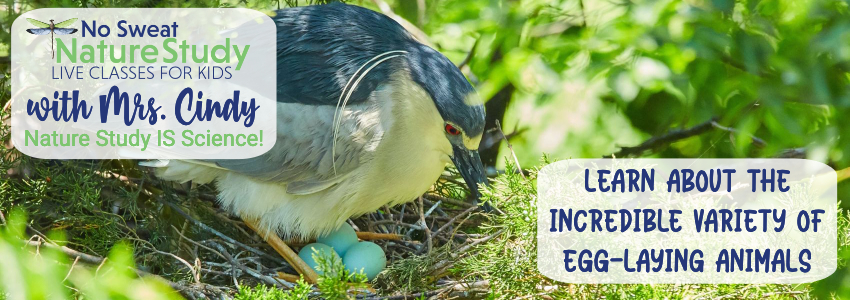Why Are Bird Eggs Different Colors? Nature Study for Kids
Have you ever wondered why bird eggs come in so many colors? From bright blue to speckled brown, the variety is not only beautiful—it’s also full of scientific meaning! In this No Sweat Nature Study Podcast episode, children will explore colorful bird eggs while building excitement for an upcoming egg-laying animals nature study video class.
Listeners will learn how egg color helps protect developing birds through camouflage, sunlight protection, and identification. Mrs. Cindy introduces the science of pigments like biliverdin and protoporphyrin in a fun, age-appropriate way. She wraps it all up with a hands-on invitation to observe actual bird nests or journal about egg designs!
Egg-Laying Animals Nature Study
After listening to the episode together, use these questions to review what your child learned and spark meaningful science conversation.
- Why do some bird eggs have colors or spots on them?
To help the eggs blend in with their surroundings and protect them from predators—this is called camouflage. - What are two reasons birds might need their eggs to be camouflaged?
To keep them hidden from predators and to protect them in open or sunny nests. - Which birds are known to lay their eggs right on the ground?
Birds like plovers and killdeer. - Why might some bird eggs be darker in color?
Darker eggs can help block too much sunlight from harming the baby bird inside. - What does the word “camouflage” mean?
Camouflage means blending in with the surroundings to stay hidden. - What are the names of the two pigments that color bird eggs?
Biliverdin and protoporphyrin. - What colors do the pigments biliverdin and protoporphyrin create?
Biliverdin makes blue and green colors; protoporphyrin makes brown and red colors. - How can bird egg color help a parent bird in a large group of nests?
It helps the parent bird identify which eggs are their own.

Egg-Laying Animals Nature Study Video Class
If your child enjoyed learning about bird egg colors, they will love “cracking open” the topic of egg-laying animals in the No Sweat Nature Study video class! In this engaging lesson, students will learn about different groups of oviparous animals—including birds, reptiles, amphibians, fish, and more. They’ll create a colorful chart to compare egg characteristics and notice interesting similarities and differences along the way.
This hands-on nature study experience brings science to life through observation, journaling, and meaningful discussion. Whether your child is fascinated by frogs, curious about turtles, or surprised to learn that some insects lay eggs, too—this class will open their eyes to the incredible diversity of egg-laying animals. Not a member yet? It’s easy to join at NoSweatNatureStudy.com and get instant access to this class and more than 150 others!

Free Nature Observation Printable Packet for All Seasons
No matter what time of year you’re listening to this episode of the No Sweat Nature Study Podcast, here’s a printable pack of nature observation activities for every season of the year!
Would you like to record a voicemail to answer this season’s nature study question?
At the end of each No Sweat Nature Study Podcast episode, Mrs. Cindy includes messages from a few of her friends. You can record a message that she might use on an upcoming episode!
All children must have their parent’s permission before leaving a recording. Parents are welcome to record an answer, too!
Each season, there will be a different question to answer. You can see this season’s question below. Think about your answer first, and then follow these simple directions:
- Click the button that says “Start recording”.
- Tell me your first name. (If you want to tell your age and/or where you live, feel free to do that.)
- You will have 60 seconds to answer the question, but try to be concise.
- Push the play button to listen to your recording before sending it to be sure it is recorded correctly. If not, record it again.
Please leave a rating or a review on your podcast app! It helps the podcast to show up for more people…which means more families can enjoy science through the wonderful lens of nature study! Thank you!
